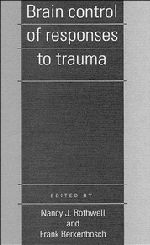Book contents
- Frontmatter
- Contents
- Contributors
- 1 Introduction
- 2 Responses to injury
- 3 Experimental approaches to the central nervous system control of responses to trauma
- 4 Neurohormonal control of cytokines during injury
- 5 Brain regions involved in modulation of immune responses
- 6 Psychological and neurobiological consequences of trauma
- 7 Central nervous system control of sickness behavior
- 8 Psychological and behavioural aspects of pain
- 9 Central control of cardiovascular responses to injury
- 10 Neuroendocrine responses to physical trauma
- 11 Central control of metabolic and thermoregulatory responses to injury
- 12 Central control of pain
- 13 The final word …
- Index
4 - Neurohormonal control of cytokines during injury
Published online by Cambridge University Press: 05 August 2016
- Frontmatter
- Contents
- Contributors
- 1 Introduction
- 2 Responses to injury
- 3 Experimental approaches to the central nervous system control of responses to trauma
- 4 Neurohormonal control of cytokines during injury
- 5 Brain regions involved in modulation of immune responses
- 6 Psychological and neurobiological consequences of trauma
- 7 Central nervous system control of sickness behavior
- 8 Psychological and behavioural aspects of pain
- 9 Central control of cardiovascular responses to injury
- 10 Neuroendocrine responses to physical trauma
- 11 Central control of metabolic and thermoregulatory responses to injury
- 12 Central control of pain
- 13 The final word …
- Index
Summary
Introduction
Hans Selye (1936a) was the first to report that a variety of noxious agents cause a profound involution of the thymus, spleen and lymph nodes, and the enlargement of the adrenal gland. In subsequent experiments, Selye found that these changes were mediated by the activation of the pituitaryadrenal axis and that glucocorticosteroids were responsible for the lymphoid involution (Selye, 1936ft). The physical, chemical, or emotional stimuli that could evoke this neuroendocrine response, were termed ‘stress’ by Selye, and the body's reaction to stress was termed the ‘general adaptation syndrome’. During stress, the initial alarm reaction is followed by a period of adaptation, when the organism shows resistance towards the stressor and the endocrine and other parameters return to normal. Eventually, with lasting stress, breakdown due to exhaustion can occur, which can lead to death (Selye, 1946, 1955). Selye (1949) was the first to describe the endocrine regulation of inflammation and observed with his colleagues that immune reactions are also subject to stress-induced alterations (Karady et al, 1938). He also demonstrated the influence of sex hormones on lymphoid organs (Selye, 1943). It is only now that the pathophysiological pathways are beginning to emerge for Selye's observations, and this, no doubt, will lead to a wider understanding and appreciation of his teachings.
Terminology
For some time, a confusion of terminology has prevailed with regards to the definition of soluble mediators, which are called hormones, growth factors, lymphokines and cytokines, and may also be classified under various other names, such as interleukins, interferons, prostaglandins, etc. By now, it is quite clear that the so-called classical hormones, neurotransmitters and immune mediators are all produced in many organs and tissues (Geenen et al,1989; Blalock, 1989; Berczi, 1990; Koenig, 1991; Ohalloranet al., 1991), and for this reason it is no longer possible to categorize a single molecule as a hormone, neurotransmitter, or cytokine. Nevertheless, one may suggest a categorization of ‘mediator functions’, which should be useful to clear the current conceptual confusion. For the purpose of our discussions, the following classifications will be adopted.
- Type
- Chapter
- Information
- Brain Control of Responses to Trauma , pp. 32 - 107Publisher: Cambridge University PressPrint publication year: 1994
- 7
- Cited by



